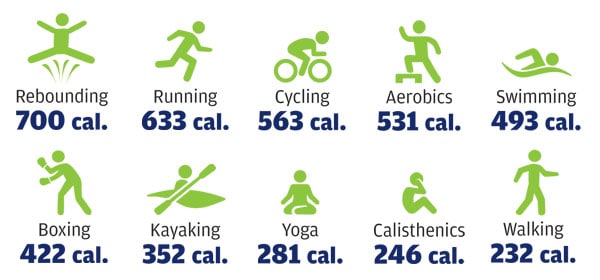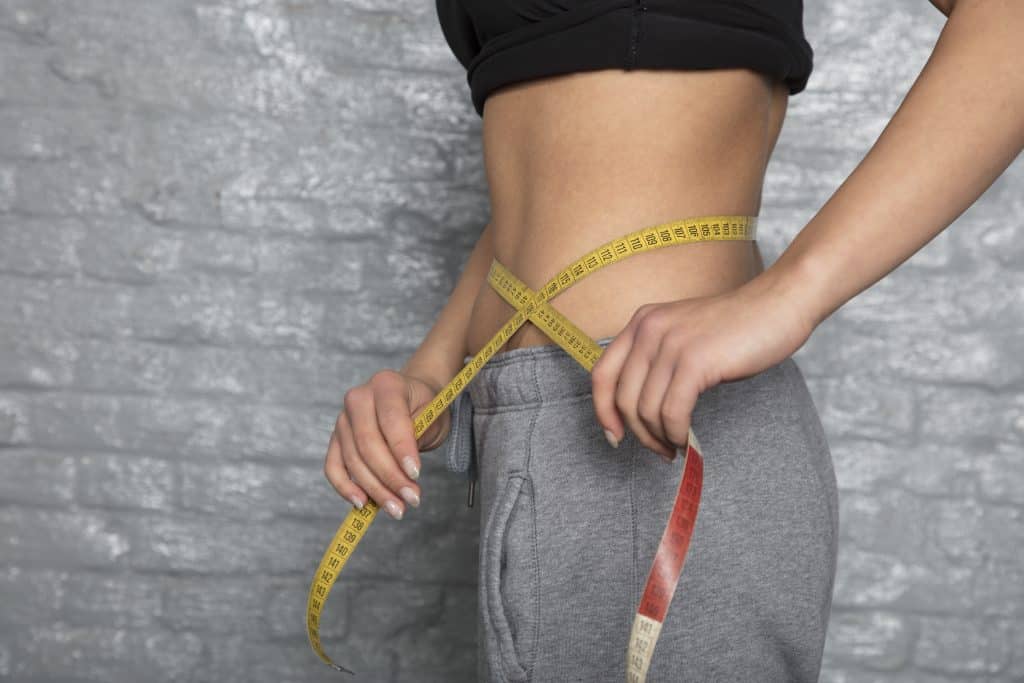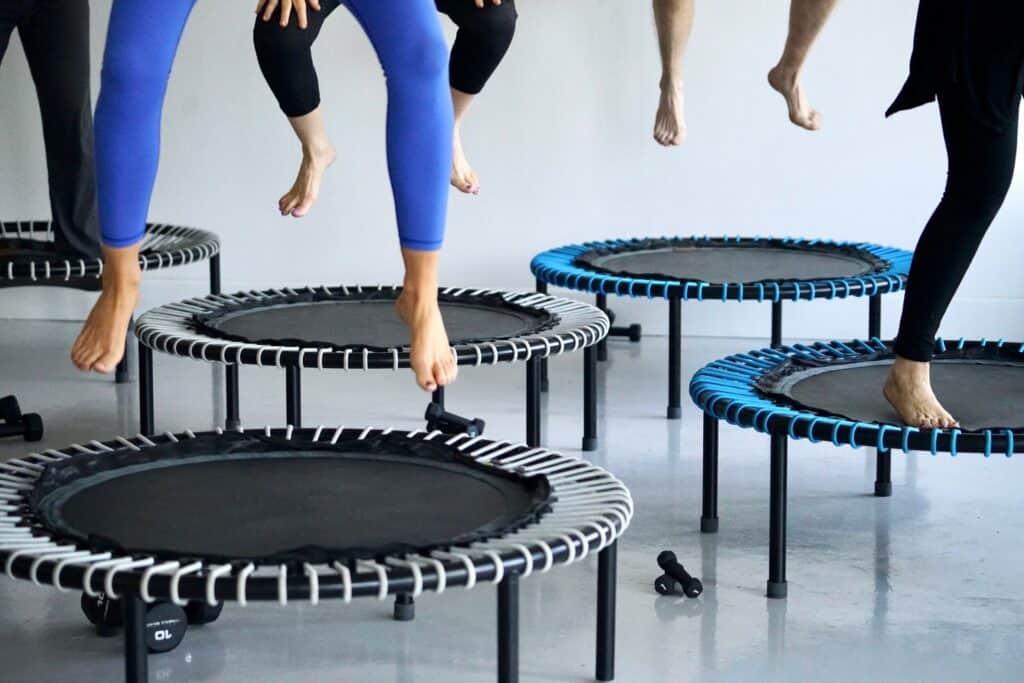How Many Calories Does a Rebounder Burn?
Rebounding is a type of cardio workout on a mini trampoline. The movement is simply jumping up and down for a given period. The best rebounders offer a whole host of health benefits such as weight loss, and getting rid of cellulite.
Does Rebounding Burn Calories?
In short, Yes it does! But How many calories does a rebounder burn? Rebounding has the ability to burn up to 700 calories. Depending on how long you perform for, in 30 minutes you can burn up to 200 calories on a rebounder. Mainly because your exercising body weight becomes heavier so you burn more calories in comparison to other exercises.
By jumping up and down repetitively on a rebounder you create G-Force. When you create this kind of force your body starts to feel an increase in pressure on the deceleration phase (bottom of the bounce). This makes your body weight heavier and you burn more calories.
This gravitational sensation activates the body’s lymphatic system. The contractions in the muscles during the rebounding movement causes up to three times as much activity in the lymphatic system than normal. Spurring the system to burn more toxins, remove pathogens and remove bacteria and waste products that accumulate in the body.
Ready to start your rebounder weight loss journey? Try out our 8-week rebounder program!

Calories burned on a rebounder
Below is a handy graphic showing how many calories burned on a rebounder in comparison to other physical activity.

How many calories can you burn in 10 minutes of rebounding
I hate to start with an “it depends” answer but unfortunately it’s the truth! There are certain factors that influence how many calories you can burn in a short period. The biggest factors that calories burned is impacted by is the intensity of the workout and your current weight. But we can dive into some averages.
I always recommend to get yourself a smartwatch that accurately counts calories, this makes it easier to keep track of your daily activity. This is the best Ive used at a reasonable price:
How many calories do you burn jumping on a trampoline
The table below is a good illustration on average of what you can burn bouncing on a trampoline. Note this does not take into account important factors like workout intensity and gender.
| Body Weight (kg/lbs) | Calories Burned (in 12 mins of rebounding) |
| 61kg / 135lbs | 75 |
| 72kg / 160lbs | 86 |
| 81kg / 180lbs | 96 |
On average, if you’re lighter and weigh around 61kg you can approximately burn 75 calories. Slightly heavier at 72kg you’re likely to burn 68 calories and a heavier adult will burn more at 96 calories. Do remember that everyone burns calories differently so this depends on many other factors but these are good averages to estimate.
Calories Burned Jumping on Mini Trampoline
When it comes to calorie burning on a mini trampoline, cardiovascular exercise of all kinds is the option to choose. Any type of workout that elevates the heart rate will burn calories.
But how each individual burns calories on a mini trampoline is different. You actually burn calories being sedentary (sitting down!). This is impacted by many factors such as weight, gender and age.
One of the biggest factors is the intensity of your workout on your mini trampoline. Needless to say, when you jump on your mini trampoline, the higher the intensity the more calories you are likely to burn. With all exercise you aim for moderate to high intensity in your given time on a rebounder.
For the example given above if you are limited to a 12 minute session then shoot for a high intensity to get the most out of your workout. But high intensity might not always be possible, if you have a higher bodyweight you may only be able to manage low to moderate intensity.

But don’t be disheartened, you can actually burn more calories if you are a larger weight. Everyone has to start somewhere! A study concluded that you can perform exercise at the same intensity but burn up to an extra 48 calories if you weigh more.
A similar study was conducted specifically on rebounding where they found that men weighing an additional 20kg burned 48 calories less in 10 minutes of rebounding.
Going on these studies it’s safe to estimate that you can burn around 50 to 150 calories in 10 minutes on a rebounder. But is this sufficient?
10 minutes per day won’t be enough to achieve your weight loss goals. To meet minimum guidelines it’s recommended to perform at least 30 minute moderate rebounding sessions per day. If you can’t commit to a daily rebounding workout then 3 high intensity workouts of 25 minutes is a recommended substitute.
Doing either of these workouts you can expect to burn around 750 – 1125 calories per week from rebounding. If you are looking to maximise your calorie burning potential always include a balanced, calorie controlled diet. Keeping this top of mind will help you achieve your weight loss goals.
Calories Burned Trampoline vs Running
A study conducted by Dr Paul E. Devore confirmed that the rebounder burns calories up to 11x faster than walking and 3x faster than running.

NASA research concluded that rebounding is 68% more effective than running at the same given intensity. A study compared 12 minutes of jogging at a moderate pace to 12 minutes moderate intensity rebounding. Results concluded that the participants at the same weight burnt 71 calories jogging compared to 82 calories rebounding.
This same study suggested that exercising on a rebounder for 10 minutes a day for four days a week is sufficient to optimise aerobic activity and burn fat.
Rebounding to Lose Belly Fat
Excess calorie consumption causes stubborn belly fat that people struggle to lose. Belly fat is not only the hardest to lose but also leads to dangerous underlying issues.
Belly fat or visceral fat can make you more susceptible to cardiovascular disease and type 2 diabetes. While looking to lose this type of belly fat, developing a solid rebounding routine can help you burn extra calories and lose that stubborn belly fat.
Here’s a great workout to maximise calories burn on the rebounder:
The main advantage of using a rebounder is when you jog with your knees up, you target the abdominal muscles during your aerobic workout routine. This combination of target abdominal work and aerobic exercise helps you more efficiently target belly fat which you cannot do with conventional exercise routines.
Another solid rebounding exercise you can do to target belly fat is oblique twists. Simply keep your feet close together with each bounce and twist your hips one direction with your shoulders pointing the other direction. Switching directions with every bounce not only targets the lower body but strengthens the core and muscles covered in unwanted belly fat.
Does Bouncing on a Trampoline Burn Calories
Much like Rebounding, bouncing on a trampoline helps to raise your heart rate and burn calories. It’s easy to incorporate into your exercise programme. Repeated bouncing offers a full body workout, low impact workout that not only burns calories but also improves your body composition and burns fat.

It is not a magic solution but helps create a calorie deficit in your daily activity. You can create a further deficit by using portion control and avoid high sugar foods. Opt for Low calorie and nutrient dense food to help you feel full and help you avoid consuming more calories.
How many Calories Can you Burn on a Trampoline?
As mentioned whether it’s on a rebounder or trampoline you will burn the same amount of calories depending on the intensity you perform the movement. but how many calories does trampolining burn? Depending on how long you perform for, using the trampoline for 30 minutes can burn up to 200 calories on a trampoline. Mainly because your exercising body weight becomes heavier so you burn more calories in comparison to other exercises.
An ex-triathlete, fitness coach and writer with a Masters in Sports Physiology. Fitness is my passion and I've had my fair share of home fitness equipment tried and tested!




2 Comments